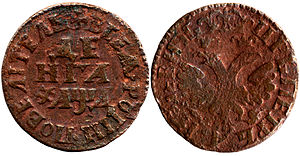- Denga
-
 A denga copper coin minted during tsar Peter I in 1704.
A denga copper coin minted during tsar Peter I in 1704.
A denga (Russian: деньга, earlier денга) was a Russian monetary unit with a value latterly equal to ½ kopeck (100 kopecks = 1 Russian ruble).
Production of dengas as minted coins began in the middle of the 14th century. In their earliest form they were imitations of the silver coinage of the khans of the Golden Horde, usually bearing blundered or meaningless legends. Weighing about a gram, they were prepared by cutting silver wire into measured lengths, beating each length flat, and then striking the resulting blank between two dies. This resulted in coins of a slightly elongated shape, often showing traces of the original wire from which they had been taken. From the time of Dmitry Donskoy onwards the coins began to take a more Russian form, with depictions of people, animals and Russian legends, although the presence of legends partly in Arabic (the language of the Horde) persisted on some coins until the time of Ivan III.
Dengas were produced only in the southern Russian principalities, with the state of Novgorod and the City of Pskov producing their own slightly larger coins. In 1535 a reform took place, with the northern "novgorodka" being valued at twice the southern denga or "moskovka". In the 1540s the production of novgorodkas depicting a horseman with a spear (Russian kop'e) began, and the larger coins were thenceforth known as kopeks. The minting of silver dengas seems to have decreased after the 16th century, as they are found less frequently in hoards, but they are known up until the reign of Peter the Great. By that time the devaluation of the coinage had proceeded to such an extent that they weighed only about 0.14 grams, and were of little practical use. In the coinage reform of 1700 they reappeared as much larger copper coins, and mintage continued, off and on, until 1916, just before the Romanov dynasty ended in 1917.
While coins minted in the 18th Century invariably showed the denomination as Denga, during parts of the 19th Century this was replaced by the word Denezhka, the diminutive form of Denga. Later still the denomination was shown simply as ½ Kopeck.
The plural form of Denga, Den'gi (Деньги) has become the usual Russian word for 'money'
Contents
Mintage
- Peter the Great (1700–1718)
- Anna Petrovna (1730–1731, 1734–1740)
- Ivan VI of Russia (1741)
- Elizabeth Petrovna (1743–1754, 1757–1760)
- Peter III of Russia (1762)
- Catherine II of Russia (1764, 1766–1775, 1783–1796)
- Paul I of Russia (1797–1801)
(19th Century mintage to follow)
See also
- Russian ruble
- Polushka a similar coin worth half a Denga
References
External links
Wikimedia Foundation. 2010.
